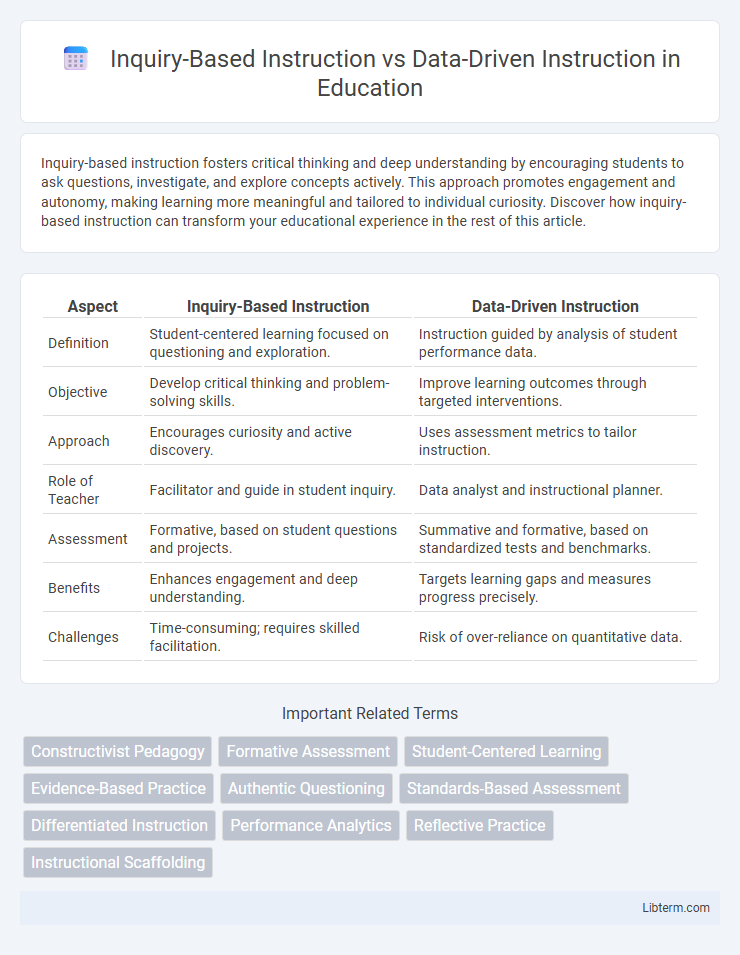Inquiry-based instruction fosters critical thinking and deep understanding by encouraging students to ask questions, investigate, and explore concepts actively. This approach promotes engagement and autonomy, making learning more meaningful and tailored to individual curiosity. Discover how inquiry-based instruction can transform your educational experience in the rest of this article.
Table of Comparison
| Aspect | Inquiry-Based Instruction | Data-Driven Instruction |
|---|---|---|
| Definition | Student-centered learning focused on questioning and exploration. | Instruction guided by analysis of student performance data. |
| Objective | Develop critical thinking and problem-solving skills. | Improve learning outcomes through targeted interventions. |
| Approach | Encourages curiosity and active discovery. | Uses assessment metrics to tailor instruction. |
| Role of Teacher | Facilitator and guide in student inquiry. | Data analyst and instructional planner. |
| Assessment | Formative, based on student questions and projects. | Summative and formative, based on standardized tests and benchmarks. |
| Benefits | Enhances engagement and deep understanding. | Targets learning gaps and measures progress precisely. |
| Challenges | Time-consuming; requires skilled facilitation. | Risk of over-reliance on quantitative data. |
Understanding Inquiry-Based Instruction
Inquiry-based instruction emphasizes student-centered learning through exploration, questioning, and hands-on activities that foster critical thinking and problem-solving skills. It encourages learners to construct knowledge by investigating real-world problems and developing hypotheses, rather than passively receiving information. Research shows this approach enhances engagement and deeper understanding compared to traditional teaching methods.
Defining Data-Driven Instruction
Data-driven instruction centers on the systematic collection and analysis of student performance data to inform teaching strategies and curriculum adjustments. This approach emphasizes measurable outcomes, using assessments, benchmarks, and analytics to tailor instruction and improve learning efficacy. By continuously monitoring data trends, educators can identify gaps, allocate resources effectively, and personalize learning experiences for better academic achievement.
Core Principles of Inquiry-Based Learning
Inquiry-based instruction centers on student-driven questioning, exploration, and critical thinking to foster deeper understanding and active engagement with content. Core principles include promoting curiosity, emphasizing process over rote memorization, and encouraging learners to construct knowledge through investigation and reflection. This approach contrasts with data-driven instruction, which primarily relies on assessment data to guide teaching and learning decisions.
Key Elements of Data-Driven Teaching
Data-driven instruction centers on the systematic collection, analysis, and application of student performance data to tailor teaching strategies that enhance learning outcomes. Key elements include the continuous assessment of student progress, use of data analytics to identify learning gaps, and informed decision-making to adjust curriculum and instructional methods. This approach ensures evidence-based interventions and targeted support that align with measurable educational goals.
Benefits of Inquiry-Based Instruction
Inquiry-Based Instruction fosters critical thinking and deep understanding by engaging students in hands-on exploration and problem-solving, leading to improved retention and application of knowledge. It promotes student autonomy and curiosity, encouraging learners to develop intellectual independence and motivation. This approach enhances collaboration and communication skills through group investigations and discussions, preparing students for real-world challenges.
Advantages of Data-Driven Instruction
Data-driven instruction leverages real-time student performance data to tailor teaching strategies, resulting in more personalized and effective learning experiences. By continuously analyzing assessment results, educators can identify knowledge gaps and adjust lesson plans to meet diverse learner needs. This approach enhances academic outcomes and promotes targeted skill development through objective decision-making.
Challenges of Inquiry-Based Approach
Inquiry-based instruction faces challenges such as the need for substantial teacher training to effectively facilitate open-ended exploration and critical thinking. Students may struggle with the lack of clear guidance, leading to confusion or frustration, which can hamper learning outcomes. Limited classroom time and resources also constrain the depth and breadth of inquiry activities compared to more structured data-driven approaches.
Limitations of Data-Driven Methods
Data-driven instruction often relies heavily on standardized test scores, which may not capture the full spectrum of student learning styles or critical thinking skills. This approach can lead to a narrow focus on quantifiable outcomes, potentially stifling creativity and inquiry-based learning processes. Educators risk neglecting formative assessments and student engagement factors that are vital for personalized instruction and deeper understanding.
Comparing Student Outcomes
Inquiry-Based Instruction fosters critical thinking and problem-solving skills by encouraging students to explore and question, often resulting in higher engagement and deeper understanding of subject material. Data-Driven Instruction relies on analyzing assessment data to tailor teaching strategies, which can lead to improved standardized test scores and targeted skill development. Studies indicate that combining both approaches can optimize student outcomes by balancing conceptual learning with measurable academic progress.
Integrating Inquiry and Data for Effective Instruction
Integrating inquiry-based instruction with data-driven instruction enhances student engagement and learning outcomes by combining student curiosity and real-time performance analytics. Utilizing formative assessments and observational data helps educators tailor inquiry activities to meet diverse learning needs and promote critical thinking. This approach fosters a dynamic classroom environment where data informs instructional adjustments while inquiry cultivates deep conceptual understanding.
Inquiry-Based Instruction Infographic

 libterm.com
libterm.com